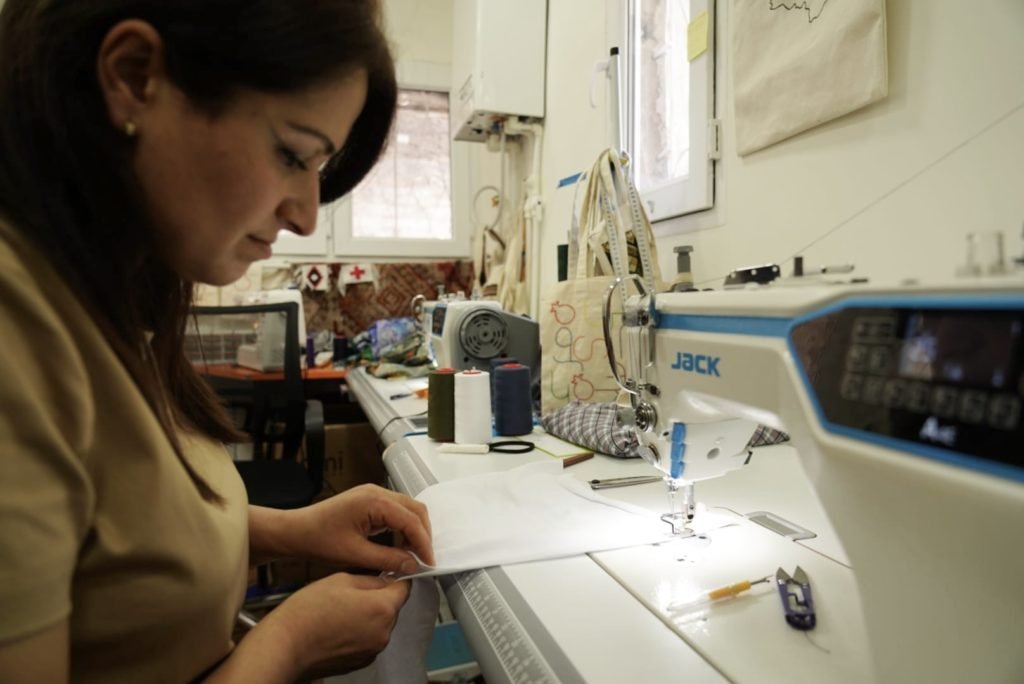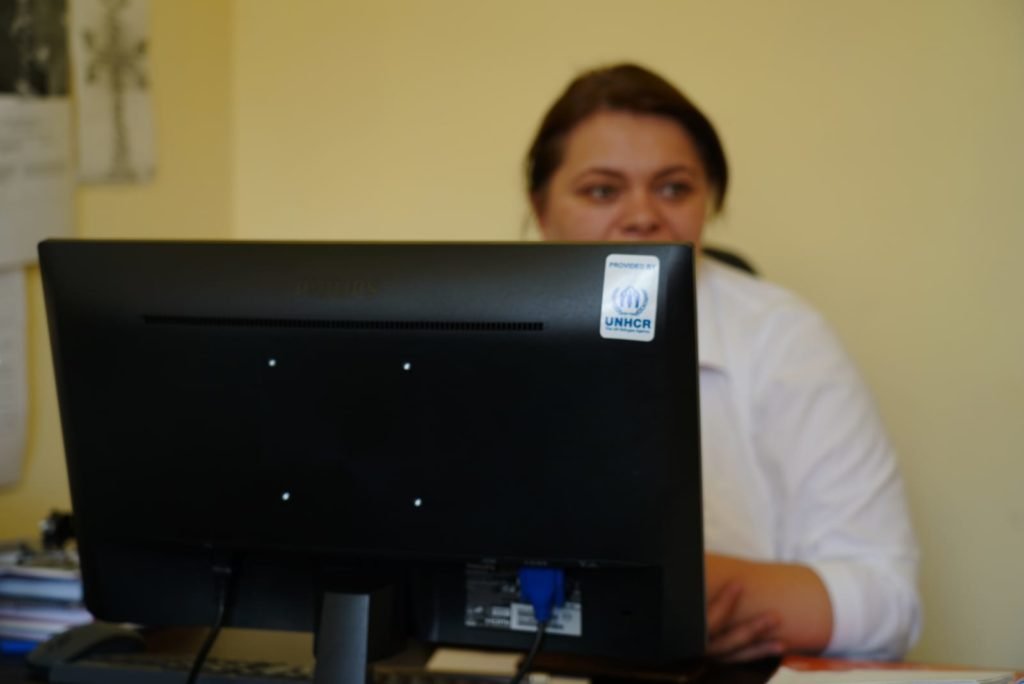
The room is buzzing with the whirring of sewing machines and the voices of children stumbling over French conjugations. Lara Asryan, a 40-year-old displaced woman and survivor of three wars from Nagorno-Karabakh (known as Artsakh by Armenians), is embroidering an outline of this turbulent territory on a white tee-shirt.
“After the war, I wanted to stay away from everyone, because as much as I would laugh and joke with people, I always hold pain in my heart,” she says softly. “But I want to keep busy. The day goes well here. I learn something new. I’m not complaining.”
Indeed, this sewing atelier — located in a 15-square-meter room inside the Francophone Cultural Center of Goris in Armenia — is a far cry from the school buildings where Asryan worked as a geography teacher and accountant back in her native town of Hadrut. After the 2020 Nagorno-Karabakh War, the region of Hadrut — including her home — was handed over to Azerbaijan.
Nagorno-Karabakh is a lush, mountainous region in the southern Caucasus, situated between Armenia and Azerbaijan. Historically populated by Armenians, it was gifted by Joseph Stalin to Azerbaijan during the Soviet era. Following the collapse of the USSR, Nagorno-Karabakh held a referendum declaring its independence. War broke out between the Armenians and Azerbaijanis, ending with a precarious ceasefire in 1994. The conflict remains frozen, with two episodes of fighting in the past 10 years: the Four-Day War of 2016 and the brutal 45-day Artsakh War of 2020.
“This last war left a very heavy wound, because we lost everything. Everything,” she recounts. “We only saved ourselves. I’m grateful to God that I have my kids with me, that my husband is alive. I say, it’s ok, we’ll live without anything, but at least we are together.”
Asryan’s husband also hails from Hadrut. With their two children in tow, they moved around the regions of Nagorno-Karabakh, following his various assignments throughout his 18-year-and-counting military career. “We’ve always been at the frontlines…at the enemy’s doorstep,” she recalls.
In March 2019, her husband was assigned near Hadrut, where the family stayed until the outbreak of the war in September 2020. Having fought in the Four-Day War of 2016, he immediately grasped that this one was not like those of the past.
“He always said, ‘This one is a different type of war. We never imagined anything like this,’” she remembers. “They thought it would be like the Four-Day War, which is why we quickly left our home, thinking we would return in a few days.”
But it would not be so. Her 13-year-old son Vahe, who takes French lessons at the same center where his mother now works, vividly remembers the days of the war in their entirety.
“It was early morning, 6:30, on September 27,” he recounts. “We were sleeping; the sun was just starting to rise. We heard an explosion. I ran to the bedroom next-door and watched a bomb hit Hadrut before my eyes. I saw the black smoke rising.” They were instructed to shelter in the basement, where they remained until 2:00 in the afternoon when they departed for their grandparents’ house in the nearby village of Azogh.
On October 1, Asryan received word that her husband had been injured. A brain concussion had left him unconscious and his legs immobile. He was brought to the hospital in Yerevan, where she and the children remained until he was able to fully recover.
“I always say, I don’t even wish unto my enemy the pain that I’ve seen,” she adds emphatically. “What I saw in those hospitals, I can’t unsee.”
In May 2021, the family briefly returned to Stepanakert, until her husband’s work was cut short by an assignment to Goris, 93 kilometers to the west in southeastern Armenia. He had strived to keep his family in Nagorno-Karabakh, to have his children live on those lands, but there was no other choice. In March of this year, the family moved to Goris, where they will remain for at least the next two years.
Asryan and her family are among the 36,000 Armenians from Nagorno-Karabakh who remain displaced in Armenia and the Armenian-controlled regions of the enclave, down from 91,000 at the height of the fighting, according to Amnesty International.
New beginnings
A longtime key transit point between Yerevan and Stepanakert, Goris sheltered around 10,000 displaced people immediately after the end of the war. Today, this number has dwindled to approximately 1,680 displaced people, according to Marianna Abgaryan, a social worker for the municipality of Goris.

Though the city was spared fighting during the 2020 war, Goris has intimately felt the effects of the conflict. The economic impact has been severe, as many citizens who farmed in Nagorno-Karabakh are now left without the same work opportunities locally. Meanwhile, residents remain acutely aware that if war were to break out again, it would begin here. “Where else would it start? We are the border. Syunik is the border,” says Abgaryan.
She notes that while the city of Goris has provided basic humanitarian resources — clothing, food and furniture — to these newcomers, they still have great need for housing and work. In January 2021, the Armenian government, for its part, determined that citizens like the Asryans who lived on lands handed over to Azerbaijan were eligible to receive 300,000 drams (at the time, approximately 577 dollars). This inspired Carmen Apounts, director of the Francophone Cultural Center of Goris, to repurpose a cozy room in the center into a sewing atelier, in collaboration with the All for Armenia and SOS Chrétiens d’Orient NGOs.
“During the war, many organizations were giving refugees first-aid assistance: hygiene packs, food and so on,” explains Apounts in flawless French. “The situation was dire. I had an idea to create work for displaced people so they would not have to continue relying on donations and to satisfy their demand for work opportunities.”

Asked why she decided to launch a workshop with a focus on women, Apounts says that most of the men were at war while their spouses arrived in Goris jobless. Her idea was to employ three women from Goris and three from Nagorno-Karabakh. Most of the women did not have extensive sewing experience at the start, but SOS Chrétiens d’Orient hired an expert teacher to quickly get them trained.
“I ask the teacher, ‘How am I doing?’” explains Asryan. “She says, ‘Very well,’ and it makes me happy. It doesn’t matter how old I am. The ability to create something with your hands gives you great satisfaction.”
Despite the warm and welcoming environment at the atelier, for which she repeatedly expresses gratitude, Asryan emphasizes that she is still looking for work in her profession, both to ensure the financial stability of her family and simply because she loves her career.
In fact, Asryan’s change in workplace is a microcosm of the “difference of mountains” — as she describes it — between her life in Hadrut and her new beginnings in Goris. She understands well that the war has transformed her mentally, but she strives to keep this deep sense of sadness hidden from her children.
“I try to make sure they always stay light and happy,” she insists, acknowledging that though she may not be able to do this all 24 hours of the day, she wishes for her children to remember little about the tragedy of 2020. “On one hand, I’m glad we had a happy life there in Artsakh before the war, so that my children can comfortably say, ‘Yes, until the war, we had a good life.’”
Looking forward…to the past
Though Asryan is in relative safety in Goris, the fear that conflict might erupt once more is ever present, exacerbated by the fact that she lives in a country where what the people see and what they hear do not correspond. “I’m the wife of a soldier,” she says. “I’m worried all day. Every morning, when my husband leaves for work, I pray that he will come home at night.”
She makes a point to avoid complaints, as despite her present predicament, she is constantly mindful of the privileges she still enjoys.
“I have many friends who have been left without husbands, brothers,” she says. “I don’t want to complain before God. I am thankful to God that my husband is here, he’s by my side, and that my children can be happy. We will work, we will grow.”
Indeed, when asked about the hardest part about leaving her native home, she is quick to acknowledge those who gave their lives in the fight for these lands.
“One is born, lives, builds, creates in one place, just to leave it all behind…but all that aside, what about our dead?” she emphasizes. She would rather have given up everything that was lost from the first day, if it meant sparing all these lives.
The aftermath of the war has also given new meaning to the word “homeland,” a term so ubiquitous in Armenian parlance. “Now, we understand the homeland more profoundly,” she says. “It’s true what they say: you have to lose something to appreciate it.”
Nevertheless, she holds onto hope of returning to the soil she characterizes as “holy.” This is why she insists on the word “displaced,” as opposed to “refugee,” to describe herself.
“We knew we didn’t live in the best conditions, that life would be better abroad, but it turns out that we lived best on our lands,” she says, smiling wistfully. “If someone offered me a mansion or just the two walls of our house, I would choose those walls in a heartbeat and return to Hadrut.”



Be the first to comment